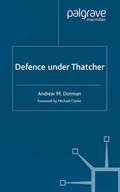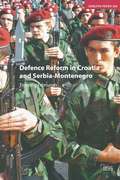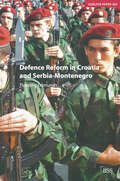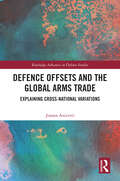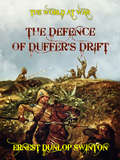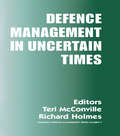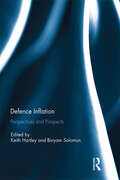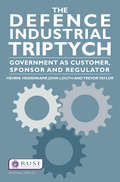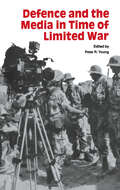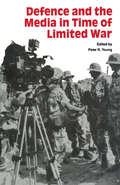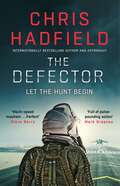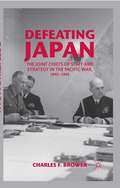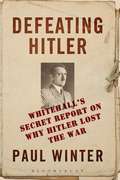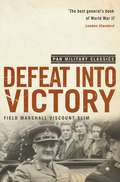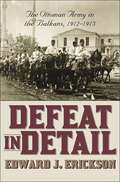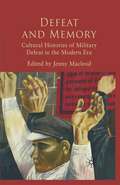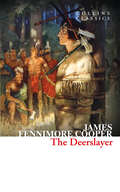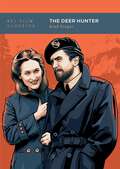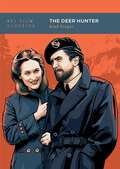- Table View
- List View
Defence Under Thatcher (Southampton Studies in International Policy)
by A. DormanDrawing upon a wide range of interviews with many of the key actors, Andrew Dorman examines how defence policy was formulated and implemented during the premiership of Margaret Thatcher. This period witnessed major transformations in international and domestic politics, with defence emerging from its traditional postwar position of relative insignificance to become one of the key issues at the 1983 and 1987 general elections. Dorman provides a new understanding of policymaking by analysing defence policy in terms of three constituent parts: declaratory policy; military strategy and procurement policy.
Defence Reform in Croatia and Serbia--Montenegro (Adelphi series)
by Timothy EdmundsThis book examines defence reform in Croatia and Serbia-Montenegro since 2000, focussing particularly on the institution and consolidation of democratic and civilian control of the armed forces, the reform of conflict-era forces structures, and the influence of the West including defence assistance and political conditionality.
Defence Reform in Croatia and Serbia--Montenegro (Adelphi series)
by Timothy EdmundsThis book examines defence reform in Croatia and Serbia-Montenegro since 2000, focussing particularly on the institution and consolidation of democratic and civilian control of the armed forces, the reform of conflict-era forces structures, and the influence of the West including defence assistance and political conditionality.
Defence Offsets and the Global Arms Trade: Explaining Cross-National Variations (Routledge Advances in Defence Studies)
by Jonata AnicettiThis book offers the first comprehensive study of defence offsets and its economic, security, political and theoretical implications.Originating in the second half of the 19th century, defence offsets - additional economic, industrial and technological benefits to states for buying foreign weapons - have since been a key feature of the global arms trade and defence industry. And yet, offsets are an under-researched and under-theorised phenomenon. This book fills this gap in the literature by offering the first general theory of defence offsets, as well as the first systematic analysis of the offset phenomenon. By building on the insights of scholars of defence economics and drawing from the International Relations liberal paradigm, as well as reviving and adapting Robert Putnam’s two-level game framework, the book proposes a liberal-rationalist theory of defence offsets. It then proves the worth of such a theory through Qualitative Comparative Analysis (QCA) of fifty-four fighter aircraft transfers from 1992 to 2021 inclusive, and three in-depth case studies addressing offsets negotiated and agreed to as part of fighter aircraft competitions in Brazil, India, and South Korea.This book will be of interest to students of defence studies, defence economics, security studies and international relations.
Defence Offsets and the Global Arms Trade: Explaining Cross-National Variations (Routledge Advances in Defence Studies)
by Jonata AnicettiThis book offers the first comprehensive study of defence offsets and its economic, security, political and theoretical implications.Originating in the second half of the 19th century, defence offsets - additional economic, industrial and technological benefits to states for buying foreign weapons - have since been a key feature of the global arms trade and defence industry. And yet, offsets are an under-researched and under-theorised phenomenon. This book fills this gap in the literature by offering the first general theory of defence offsets, as well as the first systematic analysis of the offset phenomenon. By building on the insights of scholars of defence economics and drawing from the International Relations liberal paradigm, as well as reviving and adapting Robert Putnam’s two-level game framework, the book proposes a liberal-rationalist theory of defence offsets. It then proves the worth of such a theory through Qualitative Comparative Analysis (QCA) of fifty-four fighter aircraft transfers from 1992 to 2021 inclusive, and three in-depth case studies addressing offsets negotiated and agreed to as part of fighter aircraft competitions in Brazil, India, and South Korea.This book will be of interest to students of defence studies, defence economics, security studies and international relations.
The Defence of Duffer's Drift (The World At War)
by Ernest Swinton"The Defence of Duffers Drift" is a fictional account of a young, inexperienced British officer, who is tasked with holding a river crossing with 50 troops against a larger enemy force. His initial failures and eventual victory serve as an entertaining and instructive vehicle to convey the principles of small unit tactics. Because it deals with principles, this definitive work has endured to this day and is still on some of the required reading lists of the U.S. Army and Marine Corps. (Goodreads)
Defence Management in Uncertain Times
by Teri McConville Richard HolmesFrom the impact of the attacks on New York and Washington in 2001, to the problems of military uncertainty and the role of women in combat, this collection of essays explores the changing face of militarism from the perspective of defence management experts.
Defence Management in Uncertain Times
by Teri McConville Richard HolmesFrom the impact of the attacks on New York and Washington in 2001, to the problems of military uncertainty and the role of women in combat, this collection of essays explores the changing face of militarism from the perspective of defence management experts.
Defence Inflation: Perspectives and Prospects
by Keith Hartley Binyam SolomonDefence inflation is a recurring factor in determining defence spending. It is widely reported in official government publications and in the trade press, but remains relatively neglected by defence and peace economists. In this book, international contributors from Finland, Norway, Sweden, the UK and the USA distinguish between defence inflation and cost escalation, and identify the causes of both. They use specific case studies to address a wide variety of theoretical and empirical issues and key questions, including the following: Does defence inflation affect all countries? What are its effects? Why does it occur? How (if at all) can defence inflation be controlled?While most industry and trade press devote considerable ink and space to the discussion of defence inflation, cost escalation, and their consequential impact on the purchasing dollars of the armed forces, economists have been relatively silent. This book aims to rectify this oversight through a multinational survey and analysis of the topic, while also identifying the opportunities for further theoretical and empirical research in the field. This book was originally published as a special issue of the journal Defence and Peace Economics.
Defence Inflation: Perspectives and Prospects
by Keith Hartley Binyam SolomonDefence inflation is a recurring factor in determining defence spending. It is widely reported in official government publications and in the trade press, but remains relatively neglected by defence and peace economists. In this book, international contributors from Finland, Norway, Sweden, the UK and the USA distinguish between defence inflation and cost escalation, and identify the causes of both. They use specific case studies to address a wide variety of theoretical and empirical issues and key questions, including the following: Does defence inflation affect all countries? What are its effects? Why does it occur? How (if at all) can defence inflation be controlled?While most industry and trade press devote considerable ink and space to the discussion of defence inflation, cost escalation, and their consequential impact on the purchasing dollars of the armed forces, economists have been relatively silent. This book aims to rectify this oversight through a multinational survey and analysis of the topic, while also identifying the opportunities for further theoretical and empirical research in the field. This book was originally published as a special issue of the journal Defence and Peace Economics.
The Defence Industrial Triptych: Government as a Customer, Sponsor and Regulator of Defence Industry (Whitehall Papers)
by Henrik Heidenkamp John Louth Trevor TaylorThe relationship between government and the businesses that contribute towards the defence and security of the state is a critical one; it often underscores a modern state’s foreign policy and sense of place in the world. Yet, despite its clear importance, this subject is underexplored and rarely analysed in a rigorous manner. As a consequence, government defence industrial policies, if they exist at all, often seem somewhat contrived, ill-considered and contradictory. The Defence Industrial Triptych systematically analyses the components and drivers of the relationships that bind a government to its defence industrial base by examining three major case studies: the UK, US and Germany, who between them account for over three quarters of NATO defence spending. The features of their defence industrial relationships –whether common or unique – provide vital lessons for policy-makers, industrialists and the taxpayer. As defence cuts bite across NATO and as the UK approaches the 2015 Strategic Defence and Security Review, the relationships this Whitehall Paper considers are more important than ever.
The Defence Industrial Triptych: Government as a Customer, Sponsor and Regulator of Defence Industry (Whitehall Papers)
by Henrik Heidenkamp John Louth Trevor TaylorThe relationship between government and the businesses that contribute towards the defence and security of the state is a critical one; it often underscores a modern state’s foreign policy and sense of place in the world. Yet, despite its clear importance, this subject is underexplored and rarely analysed in a rigorous manner. As a consequence, government defence industrial policies, if they exist at all, often seem somewhat contrived, ill-considered and contradictory. The Defence Industrial Triptych systematically analyses the components and drivers of the relationships that bind a government to its defence industrial base by examining three major case studies: the UK, US and Germany, who between them account for over three quarters of NATO defence spending. The features of their defence industrial relationships –whether common or unique – provide vital lessons for policy-makers, industrialists and the taxpayer. As defence cuts bite across NATO and as the UK approaches the 2015 Strategic Defence and Security Review, the relationships this Whitehall Paper considers are more important than ever.
Defence and the Media in Time of Limited War
by Peter R YoungFirst Published in 2004. Routledge is an imprint of Taylor & Francis, an informa company.
Defence and the Media in Time of Limited War
by Peter R YoungFirst Published in 2004. Routledge is an imprint of Taylor & Francis, an informa company.
The Defector: Book 2 in the Apollo Murders Series (The Apollo Murders Series)
by Chris Hadfield'A full throttle, adrenaline-laced espionage page-turner . . . Get ready to blast off and enjoy the ride!' Jack Carr, former Navy SEAL Sniper and #1 New York Times bestselling author of the James Reece Terminal List series'Continuous action, Mach-speed mayhem, sharp intrigue, and well-rounded characters - what more could you want from a thriller?' Steve Berry, New York Times bestselling author of The 9th Man and the Cotton Malone seriesIsrael, late 1973. As the Yom Kippur War flares into life, a state-of-the-art Soviet MIG fighter is racing at breakneck speed over the arid scrublands below . . . and promptly disappears.NASA Flight Controller and former US Navy test pilot Kaz Zemeckis watches the scene from the ground - and is quickly pulled into a dizzying, high-stakes game of spies, lies and a possible high-level defection that plays out across three continents. The prize is beyond value: the secrets of the Soviets' mythical 'Foxbat' MiG-25, the fastest, highest-flying fighter plane in the world and the key to Cold War air supremacy. But every defection is double-edged with risk, and Kaz must tread a careful line between trust and suspicion. Ultimately, he must invite the fox into the henhouse - bringing the defector into the heart of the United States' most secret test site - and hope that, with skill and cunning, the game plays out his way. For Chris Hadfield's second heart-stopping thriller, we move from Space to another rich and exciting part of Chris's CV: his time as a top test pilot in both the US Air Force and the US Navy, and as an RCAF fighter pilot intercepting armed Soviet bombers in North American airspace. Full of insider detail, excitement and political intrigue drawn from real events, The Defector brings us the nerve-shredding rush of aerial combat, as told by one of the world's best fighter pilots.Praise for The Apollo Murders'A nail-biting Cold War thriller' James Cameron'An exciting journey to an alternate past' Andy Weir 'Not to be missed' Frederick Forsyth 'Explosive' Gregg Hurwitz 'Exciting, authentic' Linwood Barclay
Defeating Japan: The Joint Chiefs of Staff and Strategy in the Pacific War, 1943–1945
by Charles F. BrowerThis book argues that American strategists in the Joint Chiefs of Staff were keenly aware of the inseparability of political and military aspects of strategy in the fight against Japan in World War II. They understood that war not only has political sources, it also has political purposes that establish the war's objectives and help to define the nature of the peace to follow. They understood that policy was the 'guiding intelligence' for war, in Clausewitzian terms, and that to attempt to approach strategic problems was nonsensical.
Defeating Hitler: Whitehall's Secret Report on Why Hitler Lost the War
by Paul WinterPublished for the very first time, the top secret report Some Weaknesses in German Strategy and Organisation 1933 - 1945 was prepared by Whitehall's highest intelligence body, the Joint Intelligence Committee, and presented to Britain's Chiefs of Staff in 1946 to 'set down certain aspects of the War whilst there are still sources available who were closely connected with the events described'. Paul Winter sets this unique and important document in its historical setting, providing biographies of key figures referenced in the report and a timeline of the crucial events of the Second World War.
Defeating Hitler: Whitehall's Secret Report on Why Hitler Lost the War
by Paul WinterPublished for the very first time, the top secret report Some Weaknesses in German Strategy and Organisation 1933 - 1945 was prepared by Whitehall's highest intelligence body, the Joint Intelligence Committee, and presented to Britain's Chiefs of Staff in 1946 to 'set down certain aspects of the War whilst there are still sources available who were closely connected with the events described'. Paul Winter sets this unique and important document in its historical setting, providing biographies of key figures referenced in the report and a timeline of the crucial events of the Second World War.
Defeat Into Victory: (Pan Military Classics Series) (The\great Commanders Ser.)
by William SlimField Marshal William Slim stands alongside Montgomery as the outstanding British field commander of World War II. Defeat Into Victory is his classic account of the Burma campaign: a story of retreat, attrition and final hard-fought victory over the Japanese. Told by a commander always at the centre of events, this is a narrative which captures both the high drama and the harsh reality of war.
Defeat in Detail: The Ottoman Army in the Balkans, 1912-1913 (Non-ser.)
by Edward J. EricksonNo critical analysis has ever examined the specific reasons for the Ottoman defeat. Erickson's study fills this gap by studying the operations of the Ottoman Army from October 1912 through July 1913, and by providing a comprehensive explanation of its doctrines and planning procedures. This book is written at an operational level that details every campaign at the level of the army corps. More than 30 maps, numerous orders of battle, and actual Ottoman Army operations orders illustrate how the Turks planned and fought their battles. Of particular note is the inclusion of the only detailed history in English of the Ottoman X Corps' Sarkoy amphibious invasion. Also included are definitive appendix about Ottoman military aviation and a summary of the Turks' efforts to incorporate the lessons learned from the war into their military structure in 1914.The Ottoman Empire fought the Balkan Wars of 1912-1913 against the joint forces of Bulgaria, Greece, Montenegro, and Serbia—and was decisively defeated. The Ottoman Army is frequently depicted as a mob of poorly clad, faceless Turks inept in their attempts to fight a modern war. Yet by 1912, the Ottoman Army, which was constructed on the German model, was in many ways more advanced than certain European armies.
Defeat and Memory: Cultural Histories of Military Defeat in the Modern Era
by J. MacleodThe legacy of defeat in war reverberates through private and collective memory and remains a sub-text in international relations and political discourse. This book examines the manner in which a series of military defeats have been understood and remembered by individuals and societies in the era of modern industrialised warfare.
The Deerslayer
by James Fenimore CooperBook Description In this final volume in the Leatherstocking saga, the Indian-raised Deerslayer has become a man of courage and moral certainty-and he emerges from tribal warfare with nobility as pure and proud as the wilderness whose fierce beauty and freedom have claimed his heart.
The Deerslayer: Or, The First War-path. A Tale... (Collins Classics)
by James Fenimore CooperHarperCollins is proud to present its incredible range of best-loved, essential classics.
The Deer Hunter (BFI Film Classics)
by Dr Brad PragerMichael Cimino's The Deer Hunter was met with both critical and commercial success upon its release in 1978. However, it was also highly controversial and came to be seen as a powerful statement on the human cost of America's longest war and as a colonialist glorification of anti-Asian violence. Brad Prager's study of the film considers its significance as a war movie and contextualizes its critical reception. Drawing on an archive of contemporaneous materials, as well as an in-depth analysis of the film's lighting, mise-en-scène, multiple cameras and shifting depths of field, Prager examines how the film simultaneously presents itself as a work of cinematic realism, while problematically blurring the lines between fact and fiction. While Cimino felt he had no responsibility to historical truth, depicting a highly stylized version of his own fantasies about the Vietnam War, Prager argues that The Deer Hunter's formal elements were used to bolster his troubling depictions of war and race.Finally, comparing the film with later depictions of US-led intervention such as Albert and Allen Hughes's Dead Presidents (1995) and Spike Lee's Da Five Bloods (2020), Prager illuminates The Deer Hunter's major presumptions, blind spots and omissions, while also presenting a case for its classic status.
The Deer Hunter (BFI Film Classics)
by Dr Brad PragerMichael Cimino's The Deer Hunter was met with both critical and commercial success upon its release in 1978. However, it was also highly controversial and came to be seen as a powerful statement on the human cost of America's longest war and as a colonialist glorification of anti-Asian violence. Brad Prager's study of the film considers its significance as a war movie and contextualizes its critical reception. Drawing on an archive of contemporaneous materials, as well as an in-depth analysis of the film's lighting, mise-en-scène, multiple cameras and shifting depths of field, Prager examines how the film simultaneously presents itself as a work of cinematic realism, while problematically blurring the lines between fact and fiction. While Cimino felt he had no responsibility to historical truth, depicting a highly stylized version of his own fantasies about the Vietnam War, Prager argues that The Deer Hunter's formal elements were used to bolster his troubling depictions of war and race.Finally, comparing the film with later depictions of US-led intervention such as Albert and Allen Hughes's Dead Presidents (1995) and Spike Lee's Da Five Bloods (2020), Prager illuminates The Deer Hunter's major presumptions, blind spots and omissions, while also presenting a case for its classic status.
